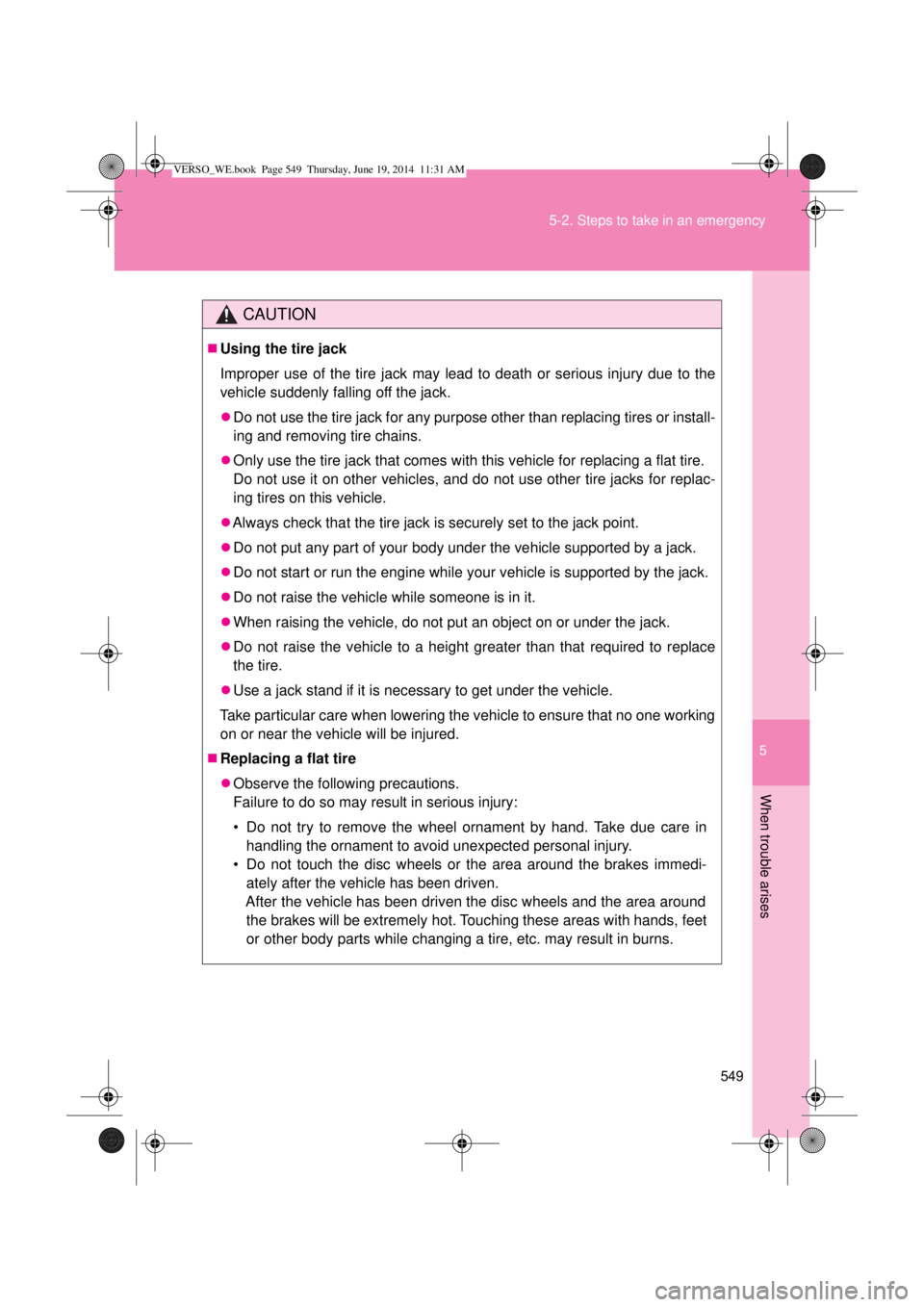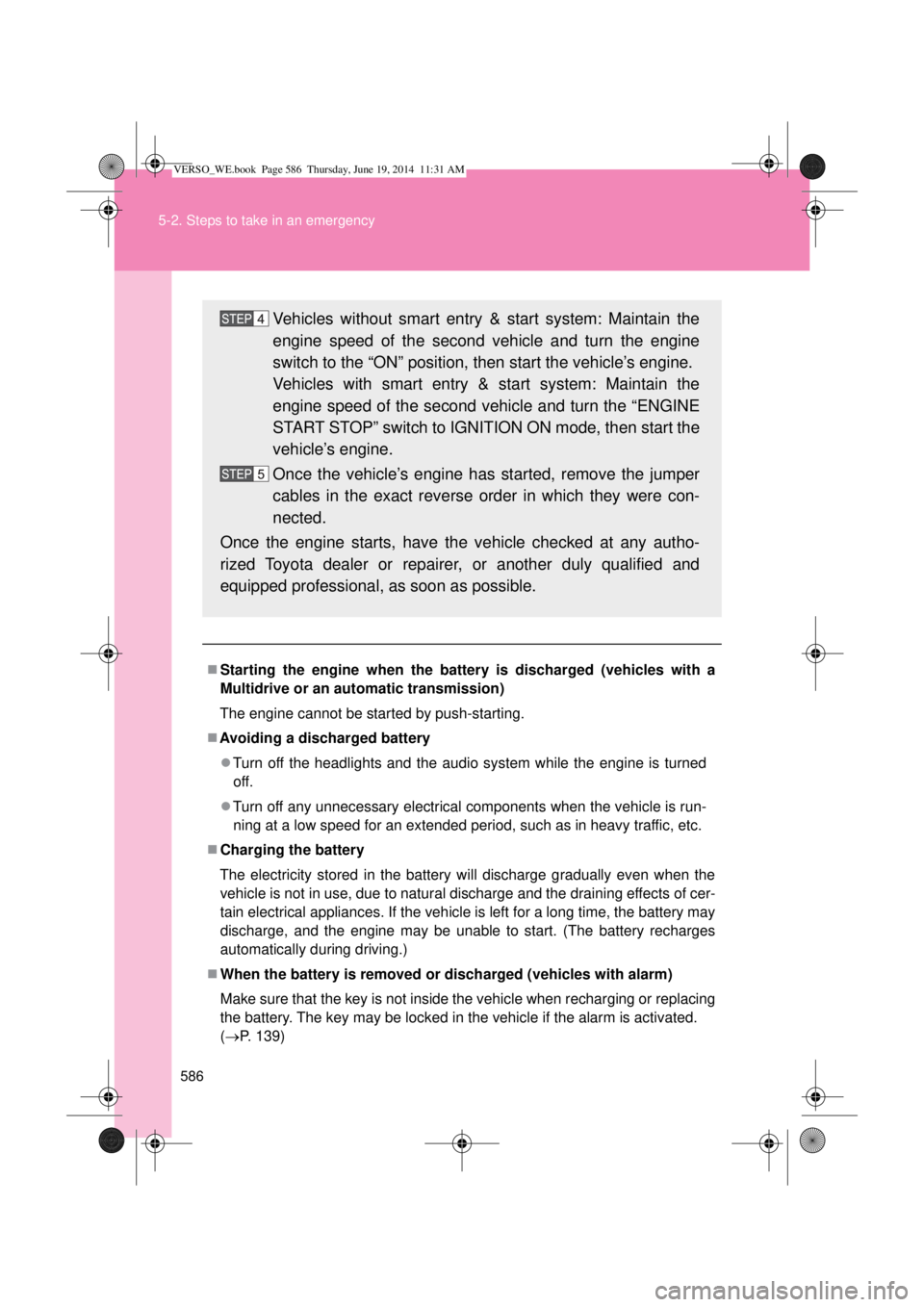Page 528 of 650
528 5-2. Steps to take in an emergency
*3
Indicates that engine
oil is scheduled to be
changed. (The indica-
tor will not work prop-
erly unless the oil
maintenance data has
been reset.)Check the level of
engine oil, and add if
necessary.
If necessary, have the
engine oil changed by
any authorized Toyota
dealer or repairer, or
another duly qualified
and equipped profes-
sional. After changing
the engine oil, the oil
change system should
be reset.
*3
Indicates that the
engine oil scheduled
be changed. (After the
engine oil is changed
and the oil mainte-
nance data has been
reset.)Check and have the
engine oil and oil filter
changed by any autho-
rized Toyota dealer or
repairer, or another duly
qualified and equipped
professional. After
changing the engine oil,
the oil change system
should be reset.
Warning messageDetailsCorrection procedure
VERSO_WE.book Page 528 Thursday, June 19, 2014 11:31 AM
Page 530 of 650
530 5-2. Steps to take in an emergency
Follow the correction procedures. (vehicles with smart entry & start system)
After taking the specified steps to correct the suspected problem,
check that the warning light turns off.
Interior
buzzerExterior
buzzerWarning messageDetailsCorrection
procedure
Once
(Flashes)Indicates that
an attempt was
made to start
the engine with-
out the elec-
tronic key being
present, or the
electronic key
was not func-
tioning normally.Confirm the
location of the
electronic key.
Once3 times
(Flashes)Indicates that a
door other than
the driver’s door
has been
opened or
closed with the
“ENGINE
START STOP”
switch in any
mode other
than off and the
electronic key
outside of the
detection area.Confirm the
location of the
electronic key.
VERSO_WE.book Page 530 Thursday, June 19, 2014 11:31 AM
Page 549 of 650

5
549 5-2. Steps to take in an emergency
When trouble arises
CAUTION
Using the tire jack
Improper use of the tire jack may lead to death or serious injury due to the
vehicle suddenly falling off the jack.
Do not use the tire jack for any purpose other than replacing tires or install-
ing and removing tire chains.
Only use the tire jack that comes with this vehicle for replacing a flat tire.
Do not use it on other vehicles, and do not use other tire jacks for replac-
ing tires on this vehicle.
Always check that the tire jack is securely set to the jack point.
Do not put any part of your body under the vehicle supported by a jack.
Do not start or run the engine while your vehicle is supported by the jack.
Do not raise the vehicle while someone is in it.
When raising the vehicle, do not put an object on or under the jack.
Do not raise the vehicle to a height greater than that required to replace
the tire.
Use a jack stand if it is necessary to get under the vehicle.
Take particular care when lowering the vehicle to ensure that no one working
on or near the vehicle will be injured.
Replacing a flat tire
Observe the following precautions.
Failure to do so may result in serious injury:
• Do not try to remove the wheel ornament by hand. Take due care in
handling the ornament to avoid unexpected personal injury.
• Do not touch the disc wheels or the area around the brakes immedi-
ately after the vehicle has been driven.
After the vehicle has been driven the disc wheels and the area around
the brakes will be extremely hot. Touching these areas with hands, feet
or other body parts while changing a tire, etc. may result in burns.
VERSO_WE.book Page 549 Thursday, June 19, 2014 11:31 AM
Page 567 of 650
5
567 5-2. Steps to take in an emergency
When trouble arises
Check the specified inflation pressure.
The label is placed as shown in the illustration.
Left-hand drive vehicles
Right-hand drive vehicles
Start the vehicle’s engine.
To inject the sealant and inflate
the tire, turn the compressor
switch on.
VERSO_WE.book Page 567 Thursday, June 19, 2014 11:31 AM
Page 578 of 650
578 5-2. Steps to take in an emergency
Vehicles with a manual transmission
Set the parking brake.
Put the shift lever in “N”.
Set the “ENGINE START STOP” switch to ACCESSORY
mode.
Press and hold the “ENGINE START STOP” switch about 15
seconds while depressing the brake pedal and clutch pedal
firmly.
Even if the engine can be started using the above steps, the system
may be malfunctioning. Have the vehicle checked by any authorized
Toyota dealer or repairer, or another duty qualified and equipped pro-
fessional.
VERSO_WE.book Page 578 Thursday, June 19, 2014 11:31 AM
Page 586 of 650

586 5-2. Steps to take in an emergency
Starting the engine when the battery is discharged (vehicles with a
Multidrive or an automatic transmission)
The engine cannot be started by push-starting.
Avoiding a discharged battery
Turn off the headlights and the audio system while the engine is turned
off.
Turn off any unnecessary electrical components when the vehicle is run-
ning at a low speed for an extended period, such as in heavy traffic, etc.
Charging the battery
The electricity stored in the battery will discharge gradually even when the
vehicle is not in use, due to natural discharge and the draining effects of cer-
tain electrical appliances. If the vehicle is left for a long time, the battery may
discharge, and the engine may be unable to start. (The battery recharges
automatically during driving.)
When the battery is removed or discharged (vehicles with alarm)
Make sure that the key is not inside the vehicle when recharging or replacing
the battery. The key may be locked in the vehicle if the alarm is activated.
(P. 139)
Vehicles without smart entry & start system: Maintain the
engine speed of the second vehicle and turn the engine
switch to the “ON” position, then start the vehicle’s engine.
Vehicles with smart entry & start system: Maintain the
engine speed of the second vehicle and turn the “ENGINE
START STOP” switch to IGNITION ON mode, then start the
vehicle’s engine.
Once the vehicle’s engine has started, remove the jumper
cables in the exact reverse order in which they were con-
nected.
Once the engine starts, have the vehicle checked at any autho-
rized Toyota dealer or repairer, or another duly qualified and
equipped professional, as soon as possible.
VERSO_WE.book Page 586 Thursday, June 19, 2014 11:31 AM
Page 590 of 650
590 5-2. Steps to take in an emergency
Diesel engine
Radiator
Cooling fans
If a large amount of coolant leaks,
immediately contact any autho-
rized Toyota dealer or repairer, or
another duly qualified and
equipped professional.
The coolant level is satisfactory if
it is between the “FULL” and
“LOW” lines on the reservoir.
Reservoir
“FULL”
“LOW”
Add coolant if necessary.
Water can be used in an emer-
gency if coolant is unavailable.
Start the engine and turn the air conditioning system on to
check that the radiator cooling fan operates and to check for
coolant leaks from the radiator or hoses.
The fan operates when the air conditioning system is turned on
immediately after a cold start. Confirm that the fan is operating by
checking the fan sound and air flow. If it is difficult to check these,
turn the air conditioning system on and off repeatedly.
(The fan may not operate in freezing temperatures.)
VERSO_WE.book Page 590 Thursday, June 19, 2014 11:31 AM
Page 600 of 650
600 6-1. Specifications
*1: Unladen vehicles
*2: Vehicles with rough road area spec
*3: Vehicle category N1 models
*4: 1ZR-FAE engine
*5: 2ZR-FAE engine
*6: 1AD-FTV engine
*7: 2AD-FHV engine
*8: 1WW-FHV engine
*9: Check the gross combination vehicle mass described on the information tag
(manufacture’s label). (P. 304, 601)
To distinguish the vehicle category, ask any authorized Toyota dealer or
repairer, or another duly qualified and equipped professional.
VERSO_WE.book Page 600 Thursday, June 19, 2014 11:31 AM